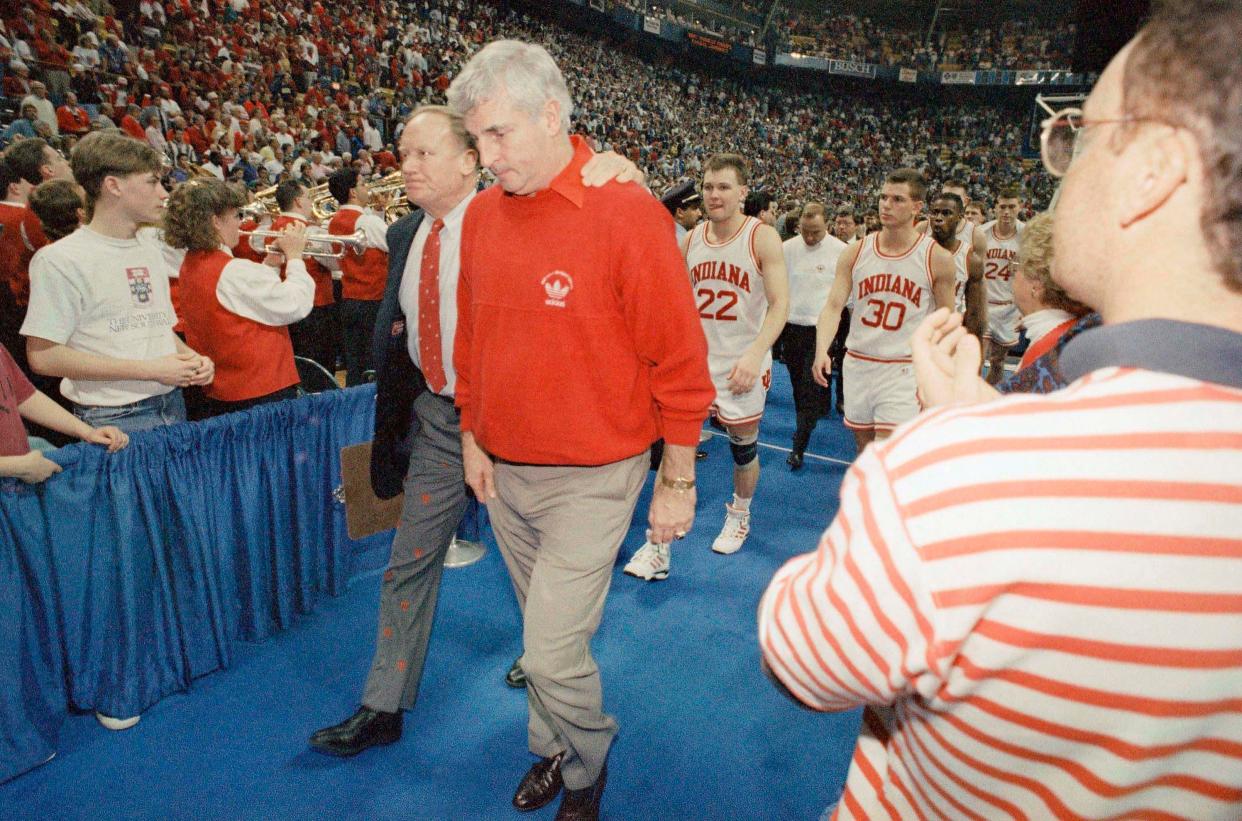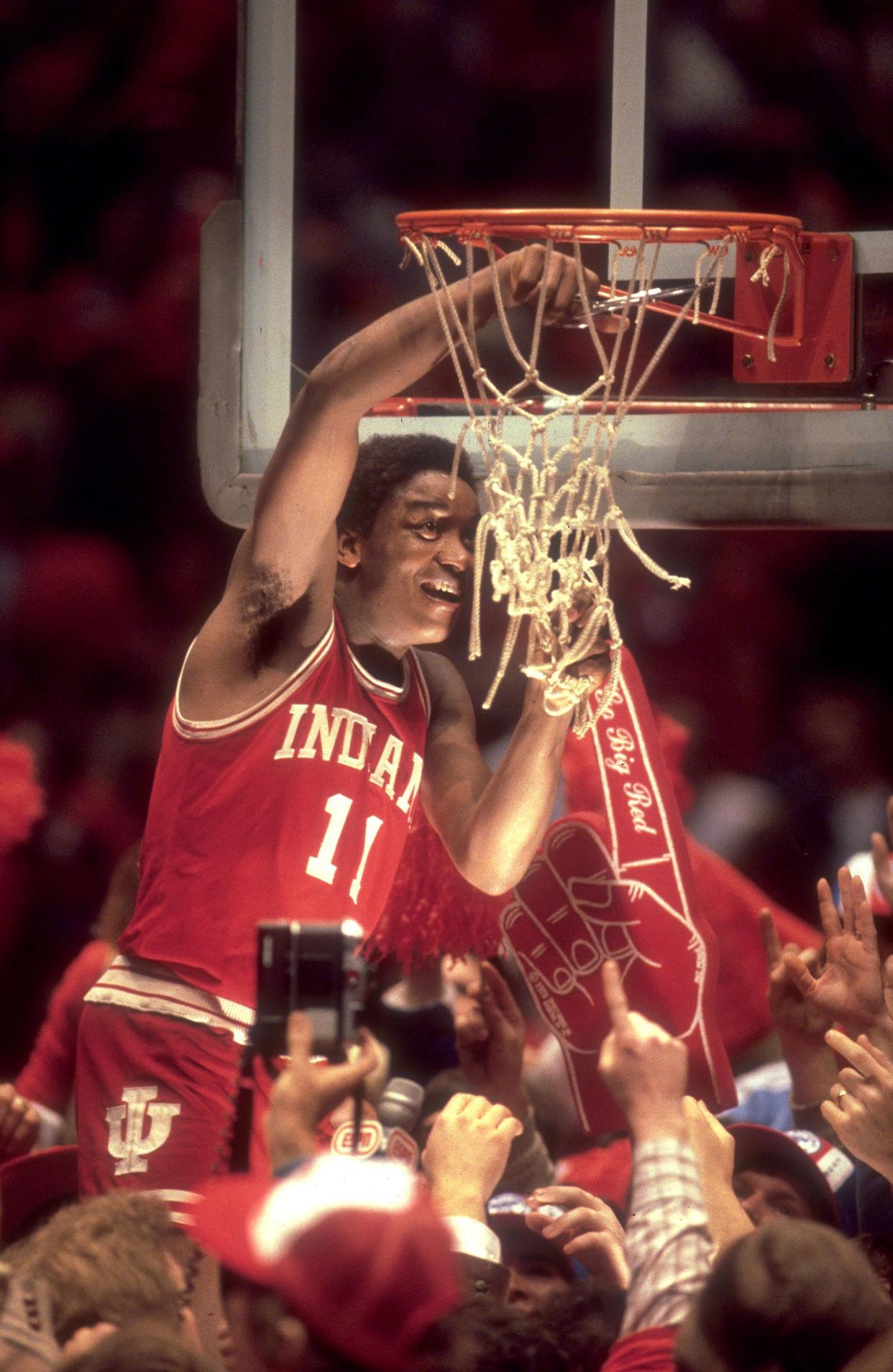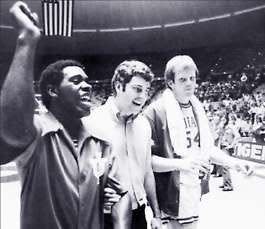Ranking Bob Knight's top 5 IU basketball teams: Undefeated champs to what-could-have-been
Bob Knight won 662 games and three national championships during his prolific and volatile tenure as Indiana basketball coach. He won 11 Big Ten titles and reached five Final Fours in his 29 seasons in Bloomington. He won at least 20 games in 21 of those seasons.
Knight died Wednesday according to a post on bobknight.com, a website that represents Knight and his foundation. He was 83.
Here are his five best Hoosiers teams, and believe it or not there's a legitimate debate about No. 1.
5. 1987 — 30-4, Big Ten champions (15-3), national champions
Led by Steve Alford, Daryl Thomas, Dean Garrett, Keith Smart and Ricky Calloway, IU was a top-10 team the entire season, peaking at No. 2. But it wasn't all smooth sailing.
"No one on the outside can really imagine what it's been like inside this basketball team," Smart said a day before his famous shot vs. Syracuse. "Coach has been tough. After our opener against Montana State he really got into us. I think we won by 35 points (90-55). We were in the locker room and he was mad and we were looking at Steve (Alford) like we were saying, 'What's it going to be like when we lose?' Now I know why. It's isn't just to win, it's the way you play. You have to learn to play your best."
A day we knew would come: The death of IU coach Bob Knight, and the reckoning of a legacy
Knight "raised hell" after a loss at Vanderbilt, but then softened after the next game, a one-point win over UNC-Wilmington.
"I walked in the locker room and for the first time in my 22 years of coaching I just told the kids, 'What the hell, we won by a point, we ought to win by a point now and then,'" Knight said. "You have no idea what it took for me to say that."
The Hoosiers would win 11 straight before a loss at No. 1 Iowa, and then won nine more in a row before a loss at No. 6 Purdue, with whom they shared the Big Ten title.
There were some close calls in the NCAA tournament: a six-point win over Duke in the Sweet 16, a one-point win over LSU in the Elite Eight, a four-point win over UNLV in the national semifinal and that famous one-point triumph over Syracuse for the title.
"Those first two teams (1976, 1981) were teams that couldn't be beat," Knight said. "They were dominant. This team won the thing by hanging in there and making some big plays. This will not go down as one of the dominant NCAA teams. We won some games by the skin of our teeth. But we were competitive, and we did get there. And we surpassed some things I wasn't sure we could do."
4. 1992-93 — 31-4, Big Ten champions (17-1), Elite Eight

Perhaps IU's last "great" team, it was the culmination of Knight's vaunted '89 recruiting class (Calberty Cheaney, Pat Graham, Greg Graham, Todd Leary, Chris Lawson, Lawrence Funderburke and Chris Reynolds). Funderburke and Lawson would eventually transfer, but that '89 class was supported on the 1992-93 team by senior Matt Nover, junior Damon Bailey, sophomore Alan Henderson and freshman Brian Evans.
The '89 class finished each of its final three seasons ranked in the AP top five. During that three-year span, the Hoosiers lost just 16 games, and they finished the 1993 season ranked No. 1 in AP poll.
In the 1992-93 season, the Hoosiers lost twice to top-5 teams in the nonconference (by six to Kansas in RCA Dome and by three to Kentucky at Freedom Hall) but then won all but one Big Ten game (an overtime loss at Ohio State).
After taking care of Louisville, 82-69, in the Sweet 16 thanks to 32 points from Cheaney and 22 from Greg Graham, the Hoosiers fell to a deep, big Kansas team in the Elite Eight.
Ranking Bob Knight's top 5 IU teams: Undefeated champs to what-could-have-been
Greg Graham insists Alan Henderson's knee injury was the only obstacle between that 1993 group and a national title.
"You ask any of those guys, the one thing that was missing from that class and those teams was a national championship," Greg Graham said. "Probably one of the greater teams that didn't win it."
“You hate to see a player like Calbert Cheaney not get to the Final Four his senior year,” Pat Graham said after the Kansas loss. “It makes me sick, but there’s nothing we can do about it. I love them like brothers. I’ll always remember this team. It was a special team.”
“This season was great for our kids,” Knight said. “The seniors, I’m incredibly pleased to have coached these kids. I think they’ve left a real impression on Indiana basketball, put a season together that we can look back on and try to get other teams to match what we got out of this season.
“We really did about everything that was available to us in this season, but get on to the next step. And God, I’d give anything for these four seniors if I could have figured out a little better plan to get us there, but we just weren’t able to make it.”
IndyStar columnist Bill Benner wrote:
"Through skill, and will, and of course, coaching, Indiana’s Hoosiers had done such a marvelous job of masking their deficiencies that we almost had forgotten they existed.
There were the injuries, to Pat Graham, and Alan Henderson, and finally, to Brian Evans.
There was the lack of size inside, the lack of overall depth, and the tendency, late in the season anyway, to have a scoring load probably shared by too few players.
Yet they had persevered, they had overcome, and they had achieved like few other teams in Indiana University’s storied basketball history.
And so we dismissed their shortcomings, considering the level at which they continued to perform, it seemed like the Hoosiers would win as long as they could field five bodies, let alone healthy ones.”
3. 1980-81 — 26-9, Big Ten champions (14-4), national champions

It was, in its own way, the most remarkable of Knight’s three titles, and certainly the one with the wildest emotional swings. At one point, the Hoosiers looked like a team spinning out of control, after a disastrous trip to Hawaii that included a loss to Pan American University and ended with a team-wide bout of food poisoning.
But it finished in triumph, the Hoosiers hoisting a national championship trophy in the old Spectrum in Philadelphia for the second time in five years.
"It was such an interesting season. The journey was very frustrating," assistant coach Jim Crews said. "The season was very rewarding, but the journey was very frustrating.”
Knight’s roster was stocked with potential: Landon Turner, Randy Wittman, Ray Tolbert, Ted Kitchel and a sophomore from Chicago named Isiah Thomas. IU started the season ranked No. 5 but were out of the Top 25 altogether after a loss to... Pan American (now Texas-Rio Grande Valley).
“To lose to Pan American, who at the time I just thought was an airline," Randy Wittman said. "Losing that and then having to fly home, I just remember when we got back, the players kind of had a meeting and said, ‘Hey, we have no room for error now.’"
IU won 13 of its next 17 games, with losses coming at Michigan (in overtime), at Purdue (by two) and a season sweep by Iowa.
More on Knight: 8 times Indiana basketball coach Bob Knight got in hot water
The second loss to Iowa was a turning point.
“Landon was guarding a kid named Kevin Boyle, a guard, 6-5, 6-6, handles the ball pretty darn good," Crews said. "He’s at the point in this possession. Landon was about 15 feet off of him. Coach says, ‘Get on him. Go guard him.’
“I mean, the game’s over. But Landon went out there, and he spread out, he moved his feet, and it was like a light came on. We moved Ted Kitchel to defensive center, undersized but tough, smart, anticipated well, all those things. And we moved Landon to defensive forward.
“Our defense took off. It was like gas on the fire.”
After that second Iowa loss, "we went out to shootaround and (Knight) didn’t come out,” Steve Risley said.
Eventually, Knight joined his players on the Assembly Hall floor. He was calm and measured. What he said changed the tone for the rest of the season.
“He comes out and he gets us all huddled, and he gives us a long speech," Risley said. "He never came out and said, ‘Isiah, take over.’ But as I recall, he used some other colloquialisms that led you to believe, let’s go play basketball and have fun, which to me was his way of saying, ‘Let Isiah take over.’ To me, he took a step back."
IU didn't lose again, running off 10 wins, culminating with the 63-50 win over North Carolina in the national title game and Isiah Thomas being named the Final Four's Most Outstanding Player.
“At that time, that team had lost more games than any other champion ever," said Bob Hammel, former Bloomington Herald-Times sports editor. "They were the direct opposite of the ’76 team. …
“By the time they were cutting down the nets in Philadelphia, I think they could’ve played that ’76 team better than anybody I can recall.”
2. 1974-75 — 31-1, Big Ten champions (18-0)
Indiana’s 1974-75 season burned brightly, before ending in disappointment.
The Hoosiers were ranked No. 1 for 11 straight weeks (Jan. 6 to March 17) and didn’t lose until the NCAA tournament regional final against Kentucky, finishing 31-1. Many believed had star forward Scott May not broken his wrist against Purdue less than a month before the NCAA tournament, the Hoosiers might have finished the season undefeated. It proved the jumping-off point for the 1975-76 team that went 32-0, the last college basketball team to finish undefeated.
Bob Knight's legacy is complex: But he made Hoosiers proud, and they never forgot it.
Some would argue, including some on the 1976 team, that the '75 group, with Steve Green and John Laskowski as seniors, was better. That's up for debate. But the loss steeled the Hoosiers for another run.
"You lose like that," May said, "you carry it with you. Sometimes in life, you are not going to be denied."
And along for the ride in his lone season as an IU grad assistant in 1975 was one of Knight's former Army players... Mike Krzyzewski.
Tom Abernethy, a junior on that team said of Krzyzewski: “He was a part of probably the best team in Indiana history."
1. 1975-76 — 32-0, Big Ten champions (18-0), national champions

The last NCAA Division I men's team to finish a season undefeated, IU spent the entire season ranked No. 1. After seeing its undefeated run ended in March the year before.
"That’s the only one where (Knight) raised the sights to say, winning a championship won’t be enough," Hammel said. "'If you guys play to your potential, you won’t lose a game. Anything short of that is a disappointment.' That’s paraphrased, obviously, but that was the feeling."
IU opened with a nationally-televised game against defending national champion UCLA... and won by 20.
"I don’t want to call it a professionalism, but it seemed like, this is the way the approach was," said Don Fischer, IU's longtime radio play-by-play announcer. "It was always professional, like, 'We know we’re good. We know we’re gonna win. And we’re gonna beat your butt.' That’s the way they went into it every game."
"It was a workman-like group," said Quinn Buckner, a senior guard on the '76 team. "We were very much like coach. We just worked. We weren’t overly concerned with how the outside viewed us. Coach Knight had a very strong presence on the group, ensuring we had a focus on what we needed to do."
Oral history: Retelling the story of the 1976 Indiana Hoosiers
1976 Hoosiers: College basketball's last unbeaten doesn't celebrate others' losses
After beating UCLA again in the national semifinal, IU faced Michigan for the national title. The Wolverines had come closest to beating the Hoosiers during the regular season. One game required a last-second Kent Benson tip-in to send the game to overtime. In the national final, Michigan led 35-29 at halftime.
"Coach didn't write anything on the board, and for a while he didn't say a word," Scott May told Sports Illustrated in 1995. "Then he said, 'If you guys want to be champions, if you want to make history and do something that maybe no other team will ever do, you've got 20 minutes to prove it.' And that was it. Somebody told me later he had waited two years to be in a position to say that."
The Hoosiers outscored Michigan 57-33 in the second half and won by 18 points.
"That 57 is still the NCAA championship record for a half," Hammel said. "And that wasn’t a great offensive team. But they played that half about as well as you can play."
As for Knight, he elected not to fly home with his team, instead going to a high school all-star game to scout.
"I’ve always felt that the tendency is to call the ’75 team better, because they obviously had better shooters with (Steve) Green and (John) Laskowski, plus all these guys. But first of all, there is an obvious advantage of another year of experience," Hammel said. "Secondly, I think that team had a resolve that it wasn’t going to happen again. That was the major plus for the ’76 team. ’75 was kind of riding along in uncharted territory. The next year, I don’t think it was any element of pinching themselves. They knew what they were. They weren’t going to lose."
Other notable teams: 1972-73 (22-6, Big Ten champions, 11-3; Final Four); 1973-74 (23-5, 12-2 Big Ten); 1979-80 (21-8, 13-5 Big Ten, Sweet 16); 1982-83 (24-6, 13-5 Big Ten, Sweet 16); 1991-92 (27-7, 14-4 Big Ten, Final Four).
This article originally appeared on Indianapolis Star: Ranking Bobby Knight's 5 best Indiana Hoosiers basketball teams
